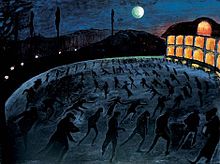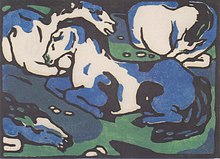New Secession

The Neue Secession was an artist group that worked mainly expressionistically . In 1910 it split from the Berlin Secession , which was led by Max Liebermann ; by the end of 1914 she organized seven exhibitions. The New Secession began its activities with the “Exhibition of Works by People Rejected by the Berlin Secession” on May 15, 1910, and was initially directed by Georg Tappert and Max Pechstein .
history
Founded in 1910
The Berlin Secession itself was founded in opposition to the conservative Academy of the Arts and the Association of Berlin Artists for Younger Artists in 1898. But twelve years later it was already so established and conservative that it no longer accepted the new developments of the following generation of artists.
In 1910 there was a split off ( Secession ) within the Berlin Secession led by Max Liebermann, when the jury rejected many works by mostly Expressionist artists, among them the Berlin painter Georg Tappert. On the initiative of Georg Tappert, followed by Max Pechstein, who represented the Dresden artist group Brücke , and other artists, the New Secession was formed, which was founded on April 21. Pechstein was the president, Tappert the first chairman of the group.
The Neue Secession existed from 1910 to 1914 and played a key role in the introduction of Expressionism in Germany. In seven exhibitions she presented works by Berlin expressionists, works by the bridge members, the artists of the later Munich Blue Rider, and numerous painters and sculptors from other German cities and from the Czech Republic and France.
Exhibitions

The New Secession opened its first exhibition on May 15th under the title "Rejected by the Secession Berlin 1910" in the Berlin art salon Maximilian Macht in Rankestrasse 1, which was planned until July 15th and was extended until the end of September.
Lotte Kaprolat (1893–1955) - formerly Georg Kolbe's model and from 1911 Pechstein's first wife - is shown on the poster for the first exhibition . Shown as an Amazon , she seems to be aiming at the Berlin Secession with an arrow on a bow. The exhibition showed 56 works by 27 artists, including works by the Brücke painters and by Otto Mueller , who got to know the artists there and soon became a group member. The Brücke members exhibited in a closed room in a red-painted room, referred to by the media as a “chamber of horrors”, they were perceived as the most radical in the first exhibition of the New Secession. The audience reacted partly shocked, as did the art critic. Pechstein described the reactions in his memoirs: "They spied on our pictures, swear words were scribbled on the frames and a painting of me [...] was pierced by a criminal with a nail or pencil." The art historian Oskar Bie formulated his criticism in the Neue Rundschau in 1910 :
- “These completely incompatible are [...] factual differences. A trend has now emerged in art that wants to reform from the lack of prejudice, from absolute naivety, bare instinct, conscious childliness, i.e. what Munch , Gauguin , van Gogh , Cézanne , Matisse and others already consider Aimed at the goal and secretly spoke in her works, turning it into a thesis: the total transfer of the painterly energy point from the material via the impression to the phantasy of the cerebrum - a kind of contempt for painting, in which the ultimate demands of modern decorative essence are expressed.

The fourth exhibition of the New Secession, which opened for the first time on November 18, 1911 in its own premises at Potsdamer Straße 122, developed into the most important event of the association. Until January 31, 1912, it showed an international overview of the latest developments in art, even before the Sonderbund exhibition in Cologne in 1912 and before Herwarth Walden's First German Autumn Salon in Berlin in 1913. Pechstein recalled: “We [...] collected [...] the names of all those who appeared to us as campaigners. I myself came into contact with the 'Blauer Reiters' group in Munich, with Franz Marc, August Macke and Kandinsky. ”This unusual exhibition in Berlin“ was largely the work of Georg Tappert. ”Tappert, in turn, had been a friend since his student days by Adolf Erbslöh , the first chairman of the Neue Künstlervereinigung München (NKVM). Both agreed on this exhibition in March 1911, and Erbslöh vouched to Tappert on April 1st for high-level exhibits: "In the interest of our mutual efforts to promote the new art, we will send our best works to your exhibition in Berlin."
During the fourth exhibition at the end of 1911, which marked the climax and at the same time the turning point, it broke. During the board elections at that time, Max Pechstein was no longer elected to the board, although he was founding president. As a consequence, Pechstein and subsequently almost all of the Brücke members left the New Secession.
Almost at the same time, the Blue Rider was founded as a spin-off from the NKVM. On December 18, 1911, the “First Exhibition of the Der Blaue Reiter editorial team” opened under the direction of Wassily Kandinsky and Franz Marc in the Thannhauser Gallery in Munich - parallel to the third exhibition of the eight remaining members of the NKVM on the floor above.
Three more exhibitions followed by the beginning of the First World War , but they could no longer build on the successes of the first four. There were also numerous traveling exhibitions in Germany and neighboring countries. Around 650 works by over 80 artists were presented at the seven exhibitions of the New Secession, and they were not limited to Expressionism. The art of Moriz Melzer or Arthur Segal, for example, does not belong in this category. The association of the New Secession tacitly dissolved in 1914.
Finale
Max Liebermann , whose art policy had been the reason for the split, resigned the chairmanship of the Berlin Secession in 1911 after further disagreements and left it in 1914. He took over the management of the then newly founded Free Secession in Berlin.
Georg Tappert, Max Pechstein, Heinrich Richter-Berlin and Moriz Melzer founded the “ Novembergruppe ” in 1918 in the Weimar Republic . It should unite and unite the “revolutionaries of the spirit (expressionists, cubists , futurists )”.
Some of the members, such as Max Pechstein and Erich Heckel , whose work was ostracized during the National Socialist era , joined the New Group , which was founded in Munich in 1946 after the Second World War .
reception
While the Berlin Secession has already been presented in many exhibitions, the New Secession has been relatively little researched. Therefore, the exhibition that opened in 2011 is Liebermann's opponent. The New Secession in Berlin and Expressionism in the Max Liebermann House on Pariser Platz , the painter's former residence, also contributed to art historical research. Contemporary exhibition reviews and catalogs were used and, with their help, reconstructed which works could be seen at the seven exhibitions of the New Secession up to 1914. Around 80 examples of paintings, sculptures and graphics were on display at the exhibition.
The curator of the exhibition Liebermann's opponents , Anke Daemgen, explains in her catalog entry that the New Secession was to be understood as a competitor and not as a counter-movement to the Berlin Secession. The term “ Secession ” is not necessarily applicable, since many artists of the New Secession were not members of the Berlin Secession and could therefore not split off from it. The difference to the competitor Berlin Secession was not essential. The members adopted many practices and often just gave them different names. For example, there was no “jury” for the exhibitions, but instead was called a “working committee”.
Artists in the exhibitions of the New Secession (selection)
Raoul Dufy , Otto Freundlich , Erich Heckel , Wassily Kandinsky , Ernst Ludwig Kirchner , César Klein , Bohumil Kubišta , Wilhelm Lehmbruck , Franz Marc , Moriz Melzer , Wilhelm Morgner , Otto Mueller , Gabriele Münter , Emil Nolde , Max Pechstein , Heinrich Richter-Berlin , Karl Schmidt-Rottluff , Arthur Segal , Georg Tappert , Marianne von Werefkin .
Exhibition of Liebermann's opponents
The exhibition Liebermann's Opponents: The New Secession in Berlin and Expressionism in the Max Liebermann House of the Brandenburg Gate Foundation ran from April 2 to July 3, 2011. The curator was Anke Daemgen, Berlin. The exhibition then ran from July 17 to October 23, 2011 in the Gottorf Castle Museum in Schleswig.
literature
- Liebermann's opponents - The New Secession in Berlin and Expressionism. Exhibition catalog, with contributions by Anke Daemgen and Uta Kuhl. Wienand, Cologne 2011, ISBN 978-3-86832-046-6 , text excerpts and paintings (PDF)
- Anke Daemgen: Liebermann's opponent . In: Museumsjournal , 3/2011
- Jörg Deuter: Liebermann's opponent. The new Secession and Expressionism . In: Journal für Kunstgeschichte 15 , 2011, pp. 119–128.
Web links
- Christina Tilmann: Horsemen of the Apocalypse . Tagesspiegel online, April 2, 2011
- Nico Kirchberger: The New Secession in a New Light . In title culture magazine , June 23, 2011
Individual evidence
- ↑ Quoted from Anke Daemgen. In: Museum journal
- ^ Anke Daemgen: The New Secession in Berlin . In: Liebermann's opponents - The New Secession in Berlin and Expressionism . Exhib. Cat., Brandenburg Gate Foundation, Max Liebermann Haus, Berlin 2011, p. 22
- ↑ Bernd Fäthke: The misappropriated woman, Lotte Pechstein, geb. Kaprolat . In: Weltkunst , 4/2005, p. 70 f
- ↑ Figure ( Memento from May 5, 2016 in the Internet Archive ), sn-herne.de, accessed on April 16, 2016
- ^ Anke Daemgen: The New Secession in Berlin . In: Liebermann's opponents - The New Secession in Berlin and Expressionism . Exhib. Cat., Brandenburg Gate Foundation, Max Liebermann Haus, Berlin 2011, p. 24
- ↑ a b Julika Pohle: Humiliated Expressionists express their anger . In: Die Welt , July 13, 2011
- ↑ Max Pechstein: Memories . With 105 drawings by the artist, (Ed.) Leopold Reidemeister, Wiesbaden 1960, p. 41 f
- ^ Oskar Bie: The new Secession . Neue Rundschau no. 21, year 1910, p. 1623 in: www.buergertum.com: Social and aesthetic elite at the crossroads (1910–1914) , accessed on July 15, 2011
- ^ Anke Daemgen: The New Secession in Berlin . In: Liebermann's opponents - The New Secession in Berlin and Expressionism . Exhib. Cat., Brandenburg Gate Foundation, Max Liebermann Haus, Berlin 2011, p. 56
- ↑ Quoted from Anke Daemgen. In: Museum journal
- ↑ Max Pechstein: Memories . With 105 drawings by the artist, (Ed.) Leopold Reidemeister, Wiesbaden 1960, p. 41
- ^ A b Gerhard Wietek : Georg Tappert 1880–1957, A trailblazer for German modernism 1880–1957 . Munich 1980, p. 31
- ↑ Bernd Fäthke: Marianne Werefkin , Munich 2001, p. 171
- ↑ Quoted by title. Culture magazine
- ↑ Annegret Hoberg, Titia Hoffmeister, Karl-Heinz Meißner: Anthology . In: The Blue Rider and the New Image, From the "New Munich Artists' Association" to the "Blue Rider" . Exhib. Cat., Städtische Galerie im Lenbachhaus, Munich 1999, p. 50
- ↑ Quoted by title. Culture magazine
- ↑ Max Liebermann. Tabular curriculum vitae in the LeMO ( DHM and HdG )
- ↑ New Group neuegruppe-hausderkunst.de, accessed 14 July 2011
- ↑ Annette Meier: From Impressionism to Cubism . ( Memento from August 11, 2011 in the Internet Archive ) Museumsportal Berlin, accessed on July 12, 2011
- ↑ Quoted by title. Culture magazine
- ↑ Anke Daemgen: Documentation on the exhibitions of the New Secession . In: Liebermann's opponents - The New Secession in Berlin and Expressionism . Exhib. Cat., Brandenburg Gate Foundation, Max Liebermann Haus, Berlin 2011, p. 200 ff.
- ^ Exhibition of Liebermann's opponents in Gottorf Castle ( Memento from January 21, 2012 in the Internet Archive )
